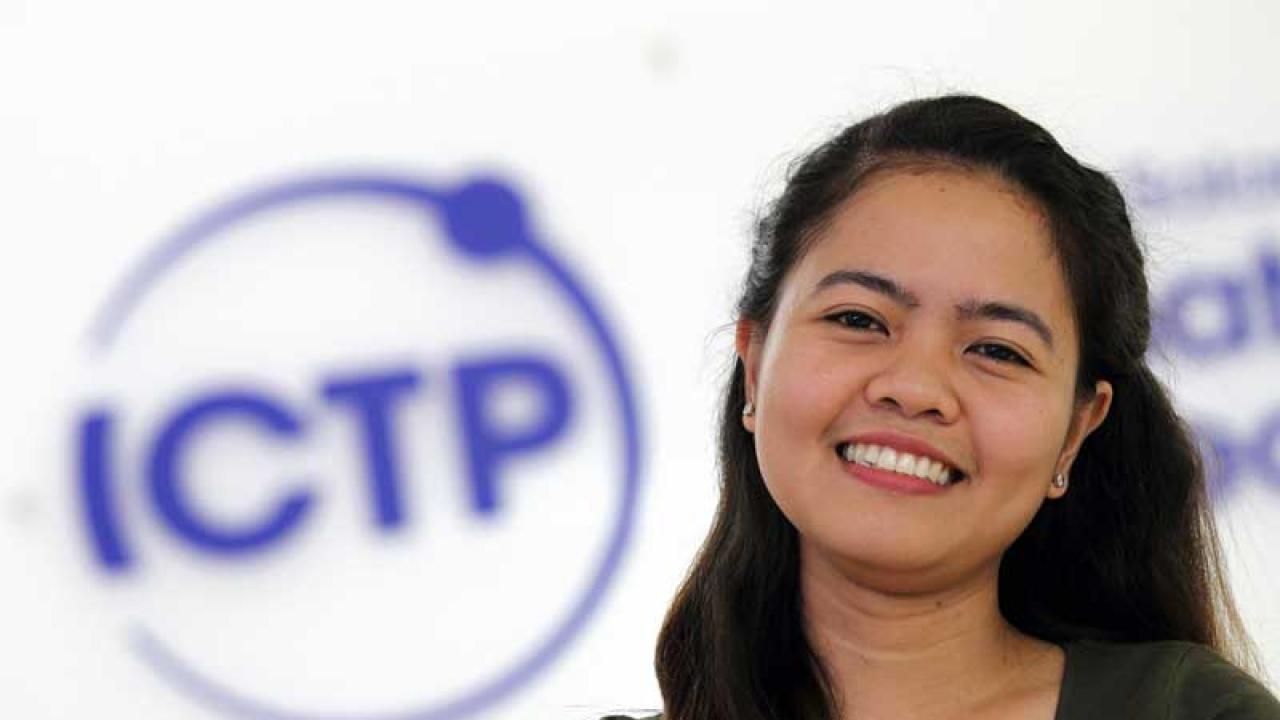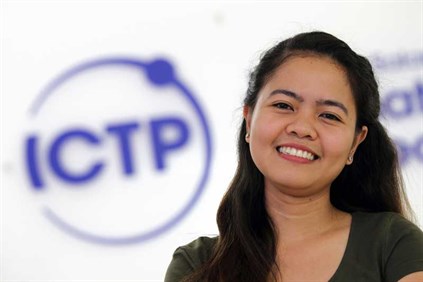
Sometimes young scientists find their field quickly, following a short and simple path to a career in research. But sometimes that path is more winding, with life and circumstance throwing a few more turns before scientists find where they flourish. ICTP Diploma graduate Florence Ramirez can attest to this, having taken her own curving path from growing up in Cebu, Philippines, to thriving in the Earth System Physics section at ICTP.
 “I’m really enjoying this programme and this field,” Ramirez says. “Geophysics is really beneficial to society, and geodynamics is fascinating to me.” Her Diploma thesis, done with ICTP scientist Karim Aoudia and OGS scientist Alessandro Vuan, investigates detection of tremors in Earth's tectonic plates in different areas of the world. It delves into a wide variety of plate behavior using a single station frequency scanning approach. “We are detecting tectonic tremors, slow earthquakes that occur in the transition zone between a seismogenic zone where earthquakes originate, and a stable, aseismic zone in well-studied subduction zones around the world,” explains Ramirez. “Monitoring slow earthquakes, which change the amound of stress in the fault system, can provide clues for the understanding the earthquake generation process, and can help improve earthquake hazard assesments."
“I’m really enjoying this programme and this field,” Ramirez says. “Geophysics is really beneficial to society, and geodynamics is fascinating to me.” Her Diploma thesis, done with ICTP scientist Karim Aoudia and OGS scientist Alessandro Vuan, investigates detection of tremors in Earth's tectonic plates in different areas of the world. It delves into a wide variety of plate behavior using a single station frequency scanning approach. “We are detecting tectonic tremors, slow earthquakes that occur in the transition zone between a seismogenic zone where earthquakes originate, and a stable, aseismic zone in well-studied subduction zones around the world,” explains Ramirez. “Monitoring slow earthquakes, which change the amound of stress in the fault system, can provide clues for the understanding the earthquake generation process, and can help improve earthquake hazard assesments."
While in high school, Ramirez never imagined she would dive into geophysics someday. “When I graduated high school, like a lot of people, I didn’t know where to go,” remembers Ramirez. Her initial idea was to do industrial engineering, but she was awarded a government scholarship to the University of San Carlos for one of three disciplines: chemical engineering, applied physics, or education. “I knew I didn’t want to do chemistry,” she laughs. “I liked math and physics, but choose physics because math is the language of physics, and to me, physics is giving meaning to math.”
After graduating university, Ramirez was ready to find a job, and she did– in the retail industry doing statistics. After a two year contract, she decided it wasn’t for her, and enrolled for a master’s degree in physics, a broad, general programme at the University of San Carlos. For her master’s thesis, she focused on spectroscopy and spent six months doing research in the Netherlands at LaserLaB Amsterdam before beginning to teach in the Philippines. Soon after, Ramirez was recruited for a a Career Incentive Programme under the Department of Science and Technology, a fellowship for recent graduates to do immersive work in government institutes. By chance, she was assigned to a project in the Philippine Institute of Volcanology and Seismology, which took her far from both spectroscopy and home.
“I really had fun in the volcano monitoring division,” Ramirez says. “It was impressive how useful and applied our work was– studying spectroscopy was nowhere near as practical and would have been expensive. You can do a lot in geophysics, especially in the Philippines.” That new love made her think forward to a further career in geophysics, and made her realize she wanted to strengthen her theoretical background before moving forward with her career. “A friend of mine suggested I apply to the ICTP Diploma program before our project in remote sensing ended, so I did. But I did not expect to be admitted because I’m at the age limit of 27.” But she was, and at the Diploma Programme graduation on 24 August, she was recognized as the top student in the Earth Systems Physics section.
With that success under her belt, Ramirez will be continuing her research at ICTP for four more months and applying to PhD programmes. “There’s a rapidly growing community of scientists in the Philippines, with some differences between fields and regions,” Ramirez says. “I would like to work in academia if possible. There’s no geophysics research group in the university where I got my bachelors and masters— it would be great to establish that group there one day.”
That may be a few years away, but the Philippines may be a good place to do that. Women comprise fifty percent of the researchers and science graduates in the country, a parity that is rare in many other more developed countries. The Philippines is also investing in research related to disaster risk and prevention, as the country is highly prone to cyclones, landslides, floods, and earthquakes. The number of students enrolled in bachelors and PhD programmes has leapt up over the last decade, which is promising, despite the number of full-time researchers remaining low. The national investment in research and development also remains low, well below the common target of one percent of GDP. Recent political developments have brought a new measure of instability to the country, but it is working towards tackling and understanding problems that affect it acutely.
Ramirez dreams of having her own lab one day, a lab that her family hopes will be back home in the Philippines. Of four siblings she is the only girl, and her parents wish she was home. “I told my parents about this programme three weeks before I moved to Italy,” Ramirez remembers. “I am really happy to have come to Italy and had this experience." Ramirez smiles. "The Postgraduate Diploma Programme and ICTP have so many students and scientists from different countries, with different personalities and different customs. It really broadened my perspective.”
---- Kelsey Calhoun
















